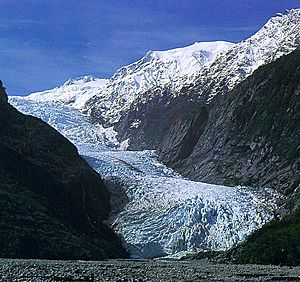Glaciers of New Zealand facts for kids
Imagine huge rivers of ice that move very slowly! These are called glaciers. New Zealand has many of them, mostly in the South Island. You'll find them high up in the Southern Alps. These are mountain glaciers found in the middle parts of the world, not just at the North or South Poles. Even the North Island has eighteen small glaciers on Mount Ruapehu.
In the 1980s, experts counted about 3,155 glaciers in the South Island. Each of these was at least as big as a football field. About one in six of these glaciers were even larger, covering more than ten football fields!
Famous Glaciers in New Zealand
New Zealand is home to some very well-known glaciers. Many people visit them every year. Some of the most famous ones include:
- Fox Glacier
- Franz Josef Glacier
- Hooker Glacier
- Mueller Glacier
- Murchison Glacier
- Tasman Glacier
- Volta Glacier
New Zealand also has a special area it looks after in Antarctica, called the Ross Dependency. This icy region also has many glaciers.
More Notable Glaciers
Here is a longer list of some other important glaciers in New Zealand:
- Agassiz Glacier (New Zealand)
- Bonar Glacier, near Mount Aspiring
- Classen Glacier
- Douglas Glacier (in Canterbury)
- Douglas Glacier (on the West Coast)
- Gray Glacier
- Godley Glacier
- Ivory Glacier
- Maud Glacier
- Mount Ruapehu glaciers
- Maruia Glacier, in the Spenser Mountains
- Olivine Ice Plateau
- Ramsay Glacier
- Rob Roy Glacier
- Therma Glacier, near Mount Aspiring
- Waiau Glacier, in the Spenser Mountains
Why Glaciers Are Shrinking
New Zealand's glaciers have been getting smaller since the late 1800s. This shrinking has sped up a lot since the 1920s. Most glaciers are now thinner and smaller than they used to be. The areas where snow builds up to feed the glaciers have also moved higher up the mountains.
For example, between 1971 and 1975, the Ivory Glacier shrank by about 30 meters (100 feet) at its end. It also lost about a quarter of its surface area during that time. Since 1980, many new small lakes have formed below the glaciers. These lakes appear behind the piles of rock and dirt left by the retreating ice. Glaciers like Classen, Godley, and Douglas now have new lakes below them. Satellite pictures show that these lakes are still growing bigger.
The biggest glaciers have lost a lot of ice. This includes the Tasman, Ivory, Classen, Mueller, Maud, Hooker, Grey, Godley, Ramsay, Murchison, Therma, Volta, and Douglas Glaciers. As they shrink, the lakes in front of them get bigger. The ice at their ends also gets thinner. From 1975 to 2005, these glaciers lost about 11% of their total ice volume.
Temporary Growth of Some Glaciers
A few glaciers, like the famous Fox and Franz Josef Glaciers on the West Coast, have sometimes grown forward. This happened especially during the 1990s. However, these small advances are tiny compared to how much they have shrunk over the last century. Both of these glaciers are now more than 2.5 kilometers (1.5 miles) shorter than they were 100 years ago.
These large glaciers are on very steep slopes and flow quickly. This means they react fast to small changes in how much snow falls and melts. If there are a few years with more westerly winds and lots of snowfall, the glaciers grow quickly. But then, when those good conditions stop, they shrink just as fast. So, when a few glaciers grow, it's usually because of short-term local weather. This weather brings more rain or snow and cooler, cloudier summers.



